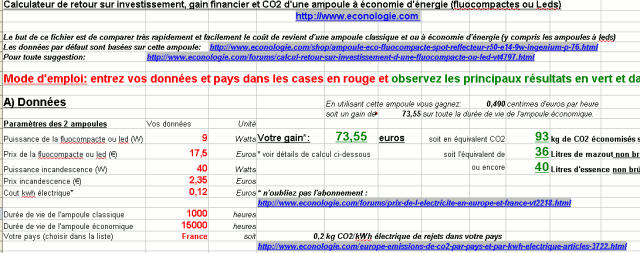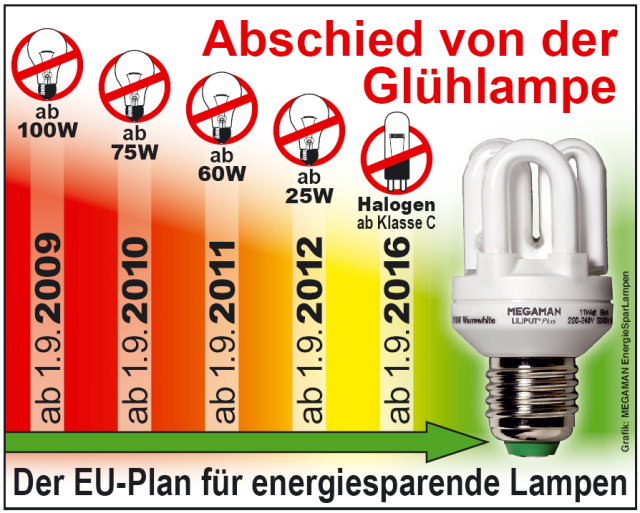
So this concerns what comparator calculator

Office version to download here: https://www.econologie.com/calcul-du-ret ... -3659.html
Live Flash version: https://www.econologie.com/calculateur-c ... -4019.html
For wide screens: https://www.econologie.com/shop/infos/ca ... gie-co2-11
News: https://www.econologie.com/electricite-r ... -3640.html
Source on the FigaroSaving energy requires, the good old bulb of Edison will have to give way to compact fluorescent lamps. Not sure, however, that these new models are completely green. All the light on the remaining gray areas.
It is done. In early December, the European Union finally pressed the switch. Now a threatened species, the incandescent bulb - 130 years on the clock - should completely go out by 2012. Objective: reduce our energy consumption in order to reduce CO2 emissions in the atmosphere. However, the new low-consumption lamps are not without drawbacks: polluting, almost all imported from Asia, pale for the most part, slow to light ... The least we can say is that they are not unanimous. Some answers likely to light our lanterns.
A good deal?
Not always. The # 1 selling point of compact fluorescent lamps is their low power consumption: 4 to 6 times less than their conventional counterparts for comparable lighting. Only downside: some manufacturers say they get a brightness equivalent to the classic 100 W with compact fluorescent bulbs at 18 W, while others display 20 W or 23 W. Difficult to navigate. In any case, assuming (which is likely) that the price of electricity does not fall, the investment can prove profitable from the first year in the case of intensive use.
The additional cost (5 to 15 € per bulb) is quickly erased by the energy savings to which are added the gains in replacing bulbs since some models have a longevity 15 times greater than the filament versions.
The site www.econologie.com also offers a calculator to assess the savings made, which can be close to a hundred euros over the total life of the bulb.
Only downside: longevity is not always in line with expectations and it decreases with repeated switching on and off. “Obviously, we especially hear the disappointed with compact fluorescent, admits Hervé Lefebvre, from Ademe. But in the panel of 10 households that we interview every year, we see an uninterrupted progression of this equipment. It was present in 000% of them in 51, whereas we should exceed 2000% in 70. It is good that consumers find their account there. ”
Manufacturing
Mercury in the spotlight. Okay, the low-consumption models are proving to consume less electricity. Okay, their longer lifespan avoids a significant overproduction of waste. But from there to stamp them “100% green” is to go a little quick in the work. Because compact fluorescent bulbs contain mercury. In minimal quantities, certainly (5 milligrams maximum, five times less than a watch battery and 100 times less than a seal).
But multiplied by several tens of millions of lamps, this heavy metal can prove frankly dangerous for the environment and health if it is not properly managed. For two years, recycling has existed (information: www.malampe.org or by calling 0810 001 777).
The fact remains that not all recyclable mercury is recovered and that, in addition, all consumers do not sort… Another black point: most compact fluorescent lamps are produced in China, shipping by sea is not necessarily more low carbon…
Start-up
Ignition failures. Low-energy light bulbs slow to start? Yes, to believe the number of dissatisfied fulminants in the forums devoted to lighting. It is not comfortable to wait a few tens of seconds, or even more than a minute, to reach optimal light. However, manufacturers have made some progress and today there are models that light up almost instantly. But while waiting for the packaging to mention the heating time, there is little other solution than to rely on the information of a good seller ...
Colors
The return of the neon style. Recurring also, the criticism concerning the pale color of the compact fluorescent, capable of transforming the most cozy of lounges into murky parking. The neon atmosphere, no thanks. To get out of it, you have to refer to what is called the "color temperature", measured in kelvins (K). In short, the higher the temperature (4 to 000 K), the colder the light and turns blue.
Conversely, the lower it is, the more the color is yellow and warm. For a rendering equivalent to incandescent models, choose a 2 K lamp instead. Do not be fooled by the indications of the “daylight” type, which is frankly white.
Can we use it everywhere?
No. Among the often overlooked disadvantages of compact fluorescent lamps is their sensitivity to cold (unlike LEDs). It is therefore better to avoid installing them outside or in unheated places. WWF's online shopping guide (www.guide-topten.com) also lists the minimum and optimal temperatures for a wide range of bulbs. Another factor to take into account is their frequent incompatibility with dimmers or their inability to be recessed. In all cases, it is better to inspect the advice for use which generally indicates these contraindications. Finally, due to their latency time at start-up and their sensitivity to repeated lighting, it is better to avoid equipping them with places of short passage (toilets, corridor, storage room).
Health
Should we fear bad waves? According to the Center for Independent Research and Information on Electromagnetic Radiation (Criirem), compact fluorescents emit electromagnetic waves. Admittedly, the radiation emitted was only recorded in the immediate vicinity. But as a precaution, the Criirem "does not recommend the use of these bulbs as bedside or desk lamps".
Should we install them now?
Yes, but little by little. One certainty: no need to massively renew its stock of bulbs, or to start stocking old models. Better to go little by little and support the gradual disappearance of filament bulbs. On the one hand, this makes it possible to assess the lighting quality of the selected model and possibly to correct the situation for the next purchase. On the other hand, the coming months should see a widening of the ranges offered and above all a more complete labeling of products. Among the information that should be mandatory by the end of the year: the number of on / off cycles, the color temperature and the lamp heating time.
Besides compact fluorescent bulbs, we should also think about monitoring other technologies such as LED lamps. Just as energy efficient, they are even more durable and easy to use, but their more limited lighting beam restricts them for the moment to the auxiliary lighting.
Finally, replacing your light bulbs will not drop your power consumption absolutely dramatically. Jean-Marc Jancovici, a specialist in global warming, recalls that other less publicized gestures are much more effective: "Just avoid using a dryer to suddenly remove the equivalent of all its consumption electric for lighting. "




